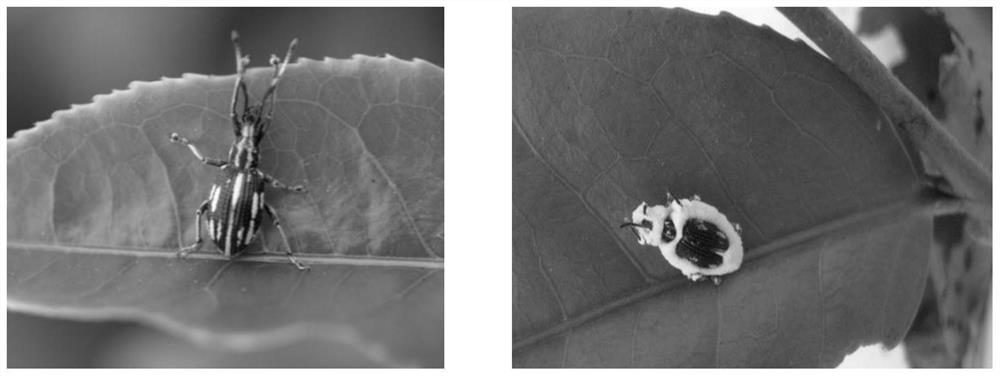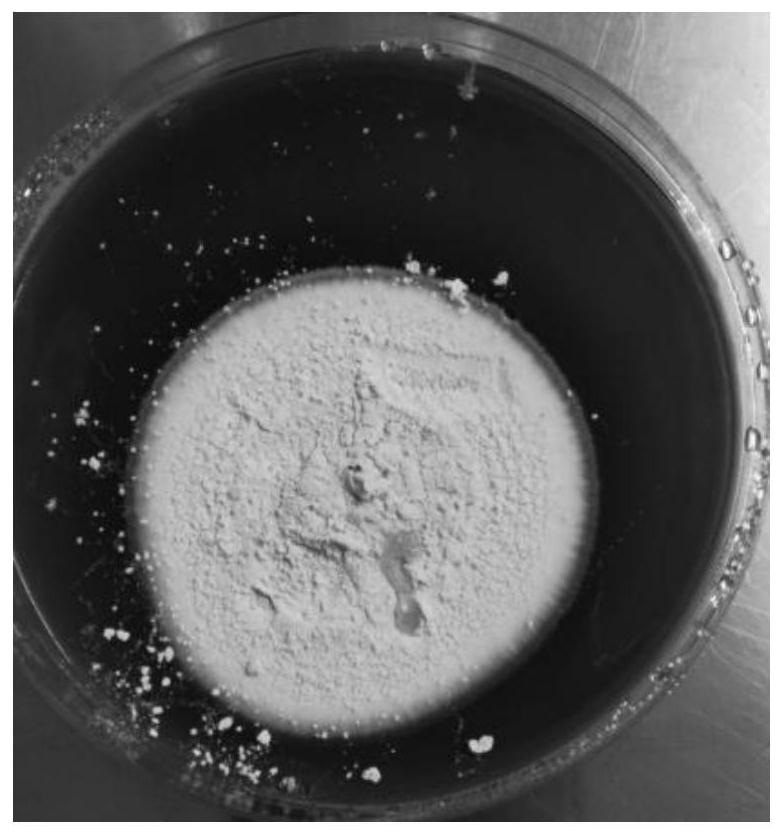Beauveria bassiana, use thereof in preventing and treating tea tree leaf-eating beetles and fungus agent
A technology of Beauveria bassiana and a fungicide, which is applied in the application, insecticide, biocide and other directions, can solve problems such as destroying the ecological environment and endangering human health, and achieves fast growth speed, strong sporulation ability, and pathogenicity. strong effect
- Summary
- Abstract
- Description
- Claims
- Application Information
AI Technical Summary
Problems solved by technology
Method used
Image
Examples
Embodiment 1
[0025] Beauveria bassiana provided by the invention, Latin formal name used at school: Beauveria bassiana (Bals.) Vuill, named after FJBb1338, has the following characteristics: the bacterial strain is collected from the tea garden of the Tea Research Institute of Fujian Academy of Agricultural Sciences, Shekou Town, Fuan City, Fujian Province It was isolated from the dead body of the weevil weevil, grown on Sabouraud medium (SDAY) at 25±1°C for 5 days, and the diameter of the colony was 17.83 mm, and reached 51.5 mm in 15 days. The colony is white to milky white, initially felt-like, and later forms a milk powder-like spore layer, which is thick and uniform. Branched hyphae, regular, colorless and smooth, sometimes growing in clusters; sporogenous cells (bottle stems) densely clustered on short and enlarged stalk cells, bottle-shaped, zigzag-shaped upper part of sporogenous cells, and tapering at the top long. Conidia are spherical or subspherical, unicellular, transparent, ...
Embodiment 2
[0031]Example 2 Isolation and identification of Beauveria bassiana FJBb1338 of the present invention
[0032] 1. Isolation of Beauveria bassiana FJBb1338
[0033] The strains to be tested were collected from the experimental tea garden of the Tea Research Institute of Fujian Academy of Agricultural Sciences, Shekou Town, Fu'an City, Fujian Province, and the corpses of the adult weevils, which died of natural diseases, were collected from the experimental tea garden. The surface of the corpses was disinfected with 5% sodium hypochlorite solution, and then The insect corpses were cut into small pieces with a scalpel, and inoculated into Dogutine oat selective medium to separate and purify, and the pure culture of the obtained strain was named Beauveria bassiana FJBb1338.
[0034] 2. Identification of Beauveria bassiana FJBb1338
[0035] (1) Morphological identification
[0036] On the SDAY medium, the colony of Beauveria bassiana FJBb1338 was white felt, and a white spore laye...
Embodiment 3
[0042] Example 3 Strain growth rate, spore production and spore germination rate of Beauveria bassiana FJBb1338 of the present invention
[0043] 0.2mL spore suspension (1.0×10 6 Spores / mL) were evenly spread on the SDAY plate and cultivated for 5 days, then punched out fresh bacterial mass from the above plate with a hole puncher with a diameter of 6mm, inoculated on the SDAY plate, and cultured at 25°C under light conditions of 12L / 12D , repeated 3 times. The colony diameters of the 5th, 10th and 15th day of culture were measured by the straightedge cross method. The measurement results showed that the colony diameter of Beauveria bassiana strain FJBb1338 cultured on the SDAY plate for 15 days could reach 51.5 mm (Table 1). Use a hole puncher with a diameter of 6mm to randomly pick a bacterial block from the center of the colony cultivated on the SDAY plate for 14 days to the edge 1 / 2, put it into a triangular flask (50mL) containing 20mL germination solution, and use a ma...
PUM
 Login to View More
Login to View More Abstract
Description
Claims
Application Information
 Login to View More
Login to View More - R&D
- Intellectual Property
- Life Sciences
- Materials
- Tech Scout
- Unparalleled Data Quality
- Higher Quality Content
- 60% Fewer Hallucinations
Browse by: Latest US Patents, China's latest patents, Technical Efficacy Thesaurus, Application Domain, Technology Topic, Popular Technical Reports.
© 2025 PatSnap. All rights reserved.Legal|Privacy policy|Modern Slavery Act Transparency Statement|Sitemap|About US| Contact US: help@patsnap.com



